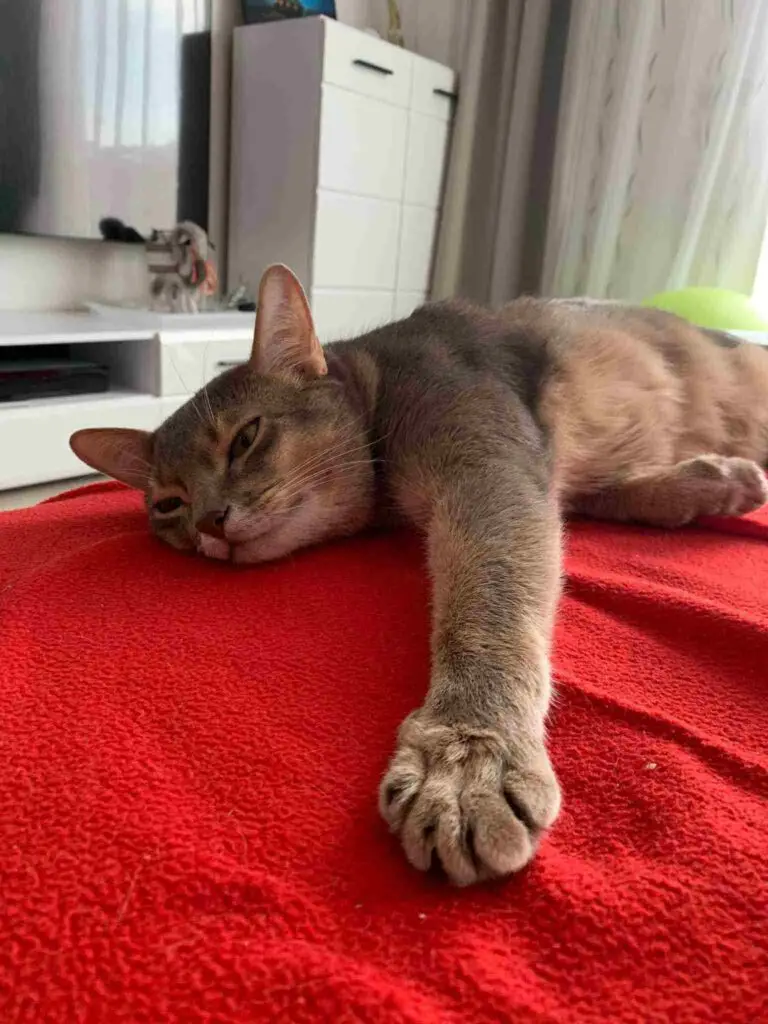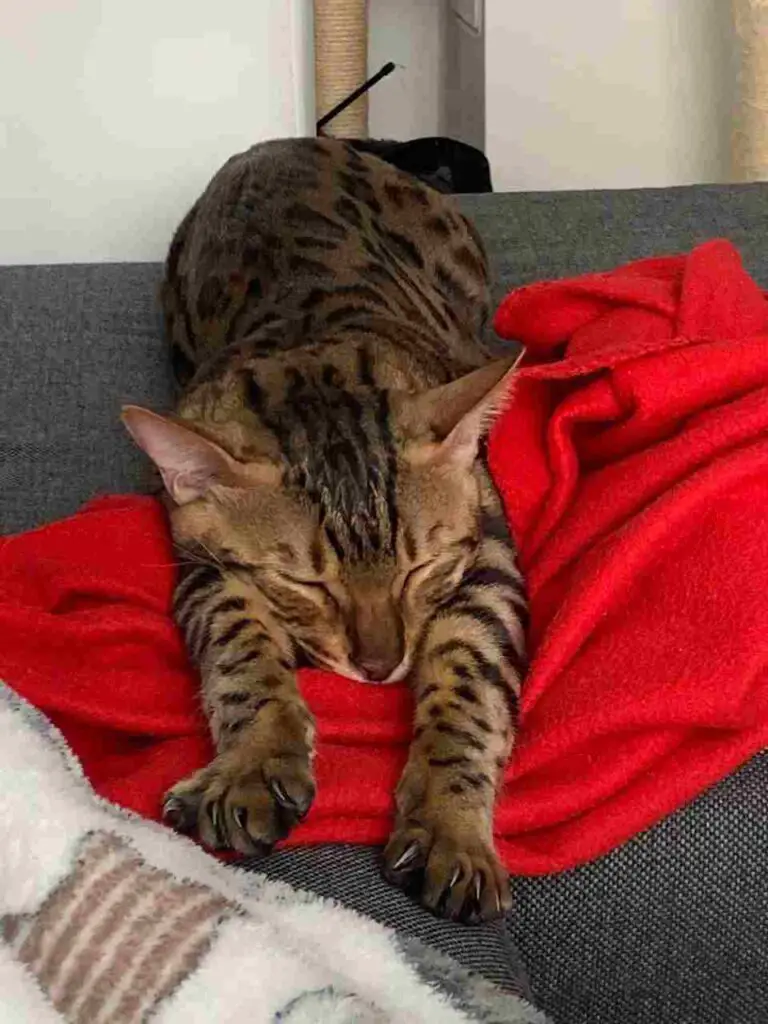Cats, known for their independent nature, often hide their emotional struggles behind a veil of self-sufficiency.
But beneath those enigmatic eyes and playful paws, loneliness can silently take its toll.
In this blog post, we’ll explore the subtle signs and behavioral cues that reveal the hidden loneliness in our feline companions, helping us foster a deeper understanding and provide the companionship they truly crave.
Benefits of Identifying Loneliness In Cats
Identifying loneliness in cats can have numerous benefits for their overall well-being, which I will quickly discuss before moving on to why you are here.
Firstly, recognizing loneliness in your cat allows us as cat owners to provide the necessary social interaction and companionship that cats crave.
Engaging in playtime, cuddling, and establishing a routine can alleviate their boredom and boost your cat’s mental stimulation.
Secondly, as a cat owner I can tell you that addressing loneliness helps prevent the development of behavioral issues such as excessive meowing, aggression, or destructive behavior.
Thirdly, identifying loneliness in cats enables owners to seek appropriate veterinary care if necessary, as some medical conditions can cause cats to isolate themselves.
Ultimately, understanding and addressing loneliness in cats can lead to happier, healthier, and more content feline companions.
Let’s move on…
How Do You Know if Your Cat is Lonely

My cat Oscar ways once lonely when switched my job back then, so I kinda of understand the sign of loneliness in cats more.
Since am not a veterinarian, I have asked other cat owners and made my online research about loneliness in cat before putting up this post.
That being said, here’s my opinion on how to know if your cat is lonely:
1. Excessive meowing or crying on your arrival home: We all know that cats can communicate through various vocalizations, and meowing is one of the ways they express their needs and emotions.
While it’s normal for cats to meow certain times, especially during feeding time or when they want attention, excessive meowing upon your arrival home could indicate loneliness or separation anxiety.
From what I observed with my cat Oscar when I switched job, your cat may be seeking interaction and companionship once they become lonely.
It’s important to observe if this behavior is consistent with your cat and if it seems to be a departure from their usual behavior.
To address this, make sure to spend quality time with your cat when you come home.
Engage in interactive play sessions, provide mental stimulation through puzzle toys or treat-dispensing toys, or simply sit with them and give them attention.
This can help alleviate their feelings of loneliness and provide the social interaction they crave.
2. Sudden or prolonged withdrawal from social interaction: ClAs we all know that cats are social animals, any sudden withdrawal from social interaction can be a sign that something is amiss, which can be a sign of loneliness.
Keep in mind that if your usually sociable cat begins hiding, avoiding contact, or retreating to secluded areas of the house, it may indicate loneliness.
It’s important to pay attention to any changes in their behavior and consider if there have been any recent changes in their environment or routine that could contribute to their loneliness.
To help your cat overcome loneliness, create a stimulating environment for your cat even if you are away.
Provide them with perches or cat trees where they can observe their surroundings, offer hiding spots like cozy beds or boxes, and provide interactive toys that encourage exercise and mental engagement.
Creating a cat-friendly space can help them feel more secure and less inclined to withdraw.
3. Sudden and excessive clingy or needy behavior on your arrival: While some cats may withdraw when feeling lonely, others may become overly clingy or needy.
If your cat exhibits an increased desire for physical contact, follows you around the house more than usual, or demands attention as soon as you arrive home, it may indicate loneliness.
They may be seeking reassurance and companionship from you when they get lonely.
To address this behavior, it’s important to provide your cat with dedicated quality time.
Engage in activities that they enjoy, such as gentle brushing, interactive play, or simply sitting with them and providing affection.
Establishing a regular routine of bonding time can help alleviate their feelings of loneliness and strengthen the bond between you and your cat.
4. Lack of interest in playing with you on your arrival home: One of the first signs that your cat may be feeling lonely is a sudden lack of enthusiasm when you return home.
Typically, cats are known for their curiosity and excitement when their owners come back.
However, if your cat seems disinterested or unresponsive to your arrival, it could be an indication of loneliness or separation anxiety.
Keep a close eye on their behavior, especially if it becomes a consistent pattern.
To determine if it’s loneliness or something else, consider the overall context in which they try to avoid any form of play or interaction.
Cats can have off days or moments when they’re simply not in the mood to play.
However, if the lack of interest persists for an extended period, and you notice other signs of loneliness, such as withdrawal or excessive sleeping, it’s more likely to be related to their emotional well-being.
5. Destructive behavior in your absence: We all know that cats are generally independent creatures, but I can tell you they still crave companionship and interaction when they can.
When they feel lonely or bored, they may resort to engaging in destructive behavior as a way to cope with their emotions.
If you come home to find scratched furniture, shredded curtains, or other signs of mischief, it could be a cry for attention and a sign of loneliness.
To differentiate loneliness from other potential causes, consider the timing and duration of the destructive behavior.
If it primarily occurs when you’re away and the cat is left alone, it’s more likely to be linked to loneliness.
However, if the behavior happens even when you’re present, it could be a sign of other issues, such as anxiety or medical problems.
In such cases, it’s best to consult with a veterinarian to rule out any underlying health concerns.
6. Change in the cat’s sleeping patterns: We all know that cats are creatures of habit, and any significant change in their sleeping patterns can be a sign of distress, including loneliness or anxiety.
If your cat suddenly starts sleeping excessively or retreats to secluded areas more often, it may indicate that they are feeling lonely and seeking solace in isolation.
To determine if loneliness is the cause, consider any recent changes in the cat’s environment or routine.
Have there been any modifications to their living space, a loss of a companion (human or animal), or a change in your schedule that might be affecting their emotional state?
If the change in sleeping patterns aligns with other signs of loneliness, it’s likely that loneliness is a contributing factor.
7. Loneliness can lead to increased aggression or irritability in cats: Cats are known for their independent nature, but they still require social interaction and companionship.
When they feel lonely, their behavior can change, and one common manifestation is increased aggression or irritability.
This can occur when cats feel frustrated or stressed due to the lack of social connection. They may hiss, swat, or even bite when approached or handled.
It’s important to note that aggression can also stem from fear or pain, so it’s crucial to assess the overall context and consult with a veterinarian or a professional animal behaviorist to rule out other potential causes.
8. Changes in litter box habits: Cats are naturally clean animals and are generally meticulous about using their litter boxes. However, loneliness can disrupt their usual litter box habits.
If your cat starts eliminating outside of the litter box or shows a decline in their litter box usage, it could be an indication of loneliness.
When cats feel lonely or stressed, they may experience changes in their elimination patterns.
They may choose to eliminate in inappropriate places as a way to seek attention or communicate their distress.
It’s important to monitor your cat’s litter box habits closely and consult with a veterinarian to rule out any underlying medical conditions that may contribute to these changes.
9. New or unusual behaviors: Loneliness in cats can also manifest through the emergence of new or unusual behaviors, that you have never witnessed.
When cats feel lonely, they may exhibit attention-seeking behaviors or engage in activities they normally wouldn’t.
Excessive meowing, especially when directed towards their owners, is a common behavior seen in lonely cats.
They may scratch furniture or engage in destructive behavior as a way to alleviate their boredom or frustration.
Some cats may become excessively clingy, following their owners around or demanding constant attention.
These behaviors are their way of seeking interaction and stimulation from their environment.
It’s important to respond to these behaviors with patience and provide appropriate outlets for their energy and attention.
To find out more about the causes of stress in cats, here’s an article I wrote about things that cause stress in cats, you can check it out.
Fixing Loneliness in Cats

Loneliness in cats can be a real concern for their well-being and frustrating to cat owners.
To address this, there are a few key strategies you can employ.
Firstly, consider adopting a second cat as a companion for your feline friend. Cats are social animals and having a playmate can greatly reduce loneliness.
Secondly, provide ample opportunities for mental and physical stimulation through interactive toys, scratching posts, and climbing structures.
This will keep your cat engaged and entertained while you are away. Additionally, make sure to dedicate quality time each day to play and interact with your cat.
Engaging in activities such as grooming or training can help strengthen the bond between you and alleviate loneliness.
Creating an enriched environment with hiding spots, cozy beds, and perches can also provide a sense of security and comfort.
Lastly, consider utilizing technology like interactive feeders or cat cameras to engage your cat while you’re away.
By implementing these strategies, you can help alleviate loneliness in your beloved feline friend.
You can also read my post on preventing stress in cats.
Conclusion
By recognizing the signs of loneliness in our feline friends, we can take proactive steps to ensure their emotional well-being. From providing interactive toys and enriching environments to dedicating quality time for bonding, we can create a safe haven where our cats feel loved, content, and truly understood. Let’s embark on this journey together and nurture the purrfect companionship our cats deserve.
Questions
Let’s take some common questions:
How can I identify loneliness in my cat?
Loneliness in cats can be identified through various signs and behaviors. Look for increased vocalization, excessive grooming, changes in appetite, decreased energy levels, and withdrawal from social interactions. It’s important to note that these signs can also indicate other health issues, so it’s best to consult with a veterinarian for a proper diagnosis.
Can cats experience loneliness?
Yes, cats can experience loneliness. Cats are social animals, and they can feel lonely if they lack companionship or stimulation. Providing them with interactive toys, engaging playtime, and a stimulating environment can help alleviate their loneliness. Consider adopting another cat as a companion, but make sure to introduce them properly to ensure a positive relationship.
How can I help my lonely cat?
To help a lonely cat, provide them with plenty of social interaction and mental stimulation. Spend quality time playing with them, provide interactive toys, and create an enriching environment with scratching posts, climbing trees, and hiding spots. Consider establishing a routine and providing a consistent environment to help them feel secure and reduce loneliness.
When should I seek professional help for my lonely cat?
If you’ve tried various strategies to alleviate your cat’s loneliness and they continue to exhibit signs of distress or withdrawal, it may be necessary to seek professional help. Consult with a veterinarian or a feline behaviorist who can assess your cat’s specific situation and provide guidance tailored to their needs.









